|
Size: 2323
Comment:
|
Size: 4646
Comment:
|
| Deletions are marked like this. | Additions are marked like this. |
| Line 19: | Line 19: |
| == Import anatomy == | == Importing anatomy == === Create the subject === |
| Line 23: | Line 24: |
=== Import the MRI === * Right-click on the subject node, and select "Import MRI". Select the file: sample_mind_neuromag/anatomy/T1.mri<<BR>><<BR>> {{attachment:mriImportMenu.gif}} {{attachment:mriFile.gif}} * The orientation of the MRI is already ok, you just have to mark all the six fiducial points, as explained in the following wiki page: [[CoordinateSystems|Coordinate systems]]. Click on save button when you're done.<<BR>><<BR>> {{attachment:fiducials.gif}} * If at some point you do not see the files you've just imported in the database explorer, you just need to refresh the display: by pressing F5, or using the menu File > Refresh tree display. === Import the surfaces === * Right-click again on the subject node, and select "Import surfaces". Select the "FreeSurfer surfaces" file type, and select all the surface files at once, holding the SHIFT or CTRL buttons. Click on Open.<<BR>><<BR>> {{attachment:surfaceFiles.gif}} * Answer "Yes" to the question "Align surfaces with MRI now?". You should see the following nodes in the database.<<BR>><<BR>> {{attachment:surfListInit.gif}} * "outer skin" = Head, used for surfaces/MRI registration * "inner skull" = Internal surface of the skull, used for the computation of the "overlapping spheres" forward model * "lh" = Left hemisphere * "rh" = Right hemisphere * "pial" = External cortical surface = grey matter/CSF interface (used for source estimation) * "white" = External white matter surface = interface between the grey and the white matter (not used in this tutorial) * Downsample the two pial and the two white surfaces to 7,500 vertices each (right-click > Less vertices) * Merge the two downsampled hemispheres of the pial surface (select both lh.pial_7500 and rh.pial_7500 files, right-click > Merge surfaces). Rename the new surface in "cortex". * Do the same with the white matter. Call the result "white". * Delete all the intermediate lh and rh surfaces. Rename the head and the inner skull with shorter names. Display all the surfaces and play with the colors and transparency to check that everything what imported correctly. You should obtain something like this:<<BR>><<BR>> {{attachment:surfListFinal.gif}} {{attachment:surfTest.gif}} == Importing MEG recordings == |
Import and process Neuromag raw recordings
This tutorial describes how to process raw Neuromag recordings. It is based on median nerve stimulation acquired at MGH in 2005.
This document shows what to do step by step, but does not really explain what is happening, the meaning of the different options or processes, the issues or bugs you can encounter, and does not provide an exhaustive description of the software features. Those topics are introduced in the basic tutorials based on CTF recordings; so make sure that you followed all those initial tutorials before going through this one.
The script file tutorial_mind_neuromag.m in the brainstorm3/toolbox/script folder performs exactly the same tasks automatically, without any user interaction. Please have a look at this file if you plan to write scripts to process recordings in .fif format.
Contents
Download and installation
- It is considered that you followed all the basic tutorials and that you already have a fully working copy of Brainstorm installed on your computer.
Go to the Download page of this website, and dowload the file "bst_sample_mind_neuromag.zip".
- Unzip it in a folder that is not in any of the Brainstorm folders (program folder or database folder). This is really important that you always keep your original data files in a separate folder: the program folder can be deleted when updating the software, and the contents of the database folder is supposed to be manipulated only by the program itself.
- Start Brainstorm (Matlab scripts or stand-alone version)
- In the protocols drop-down list, select the menu "Create new protocol".
Name it "TutorialNeuromag", and select all the options as illustrated: No default anatomy, Use inidividual anatomy, Use one channel file per condition.
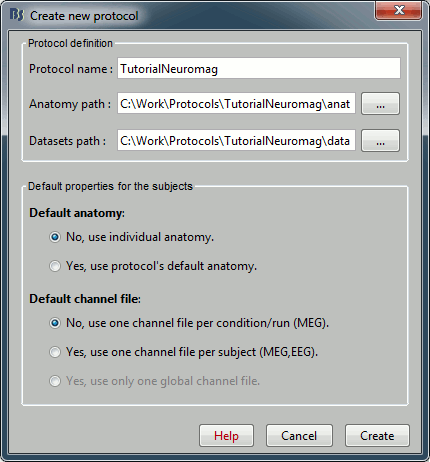
Importing anatomy
Create the subject
- Select the "Anatomy" exploration mode (first button in the toolbar above the database explorer).
Right-click on the protocol node and select "New subject".
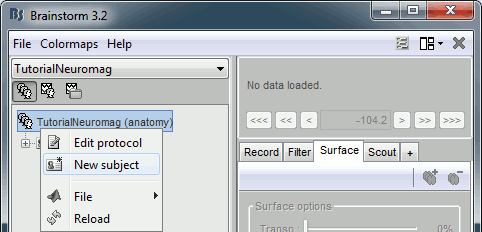
You can leave the default name "Subject01" and the default options. Then click on Save.
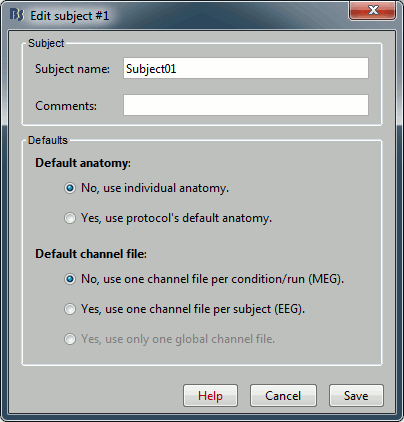
Import the MRI
Right-click on the subject node, and select "Import MRI". Select the file: sample_mind_neuromag/anatomy/T1.mri
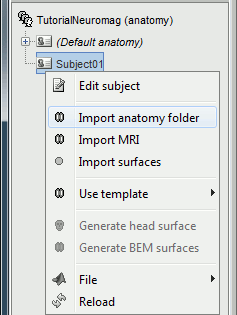
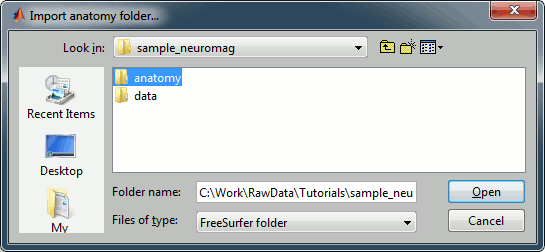
The orientation of the MRI is already ok, you just have to mark all the six fiducial points, as explained in the following wiki page: Coordinate systems. Click on save button when you're done.
![[ATTACH] [ATTACH]](/moin_static1911/brainstorm1/img/attach.png)
If at some point you do not see the files you've just imported in the database explorer, you just need to refresh the display: by pressing F5, or using the menu File > Refresh tree display.
Import the surfaces
Right-click again on the subject node, and select "Import surfaces". Select the "FreeSurfer surfaces" file type, and select all the surface files at once, holding the SHIFT or CTRL buttons. Click on Open.
![[ATTACH] [ATTACH]](/moin_static1911/brainstorm1/img/attach.png)
Answer "Yes" to the question "Align surfaces with MRI now?". You should see the following nodes in the database.
![[ATTACH] [ATTACH]](/moin_static1911/brainstorm1/img/attach.png)
- "outer skin" = Head, used for surfaces/MRI registration
- "inner skull" = Internal surface of the skull, used for the computation of the "overlapping spheres" forward model
- "lh" = Left hemisphere
- "rh" = Right hemisphere
- "pial" = External cortical surface = grey matter/CSF interface (used for source estimation)
- "white" = External white matter surface = interface between the grey and the white matter (not used in this tutorial)
Downsample the two pial and the two white surfaces to 7,500 vertices each (right-click > Less vertices)
Merge the two downsampled hemispheres of the pial surface (select both lh.pial_7500 and rh.pial_7500 files, right-click > Merge surfaces). Rename the new surface in "cortex".
- Do the same with the white matter. Call the result "white".
Delete all the intermediate lh and rh surfaces. Rename the head and the inner skull with shorter names. Display all the surfaces and play with the colors and transparency to check that everything what imported correctly. You should obtain something like this:
![[ATTACH] [ATTACH]](/moin_static1911/brainstorm1/img/attach.png)
![[ATTACH] [ATTACH]](/moin_static1911/brainstorm1/img/attach.png)
